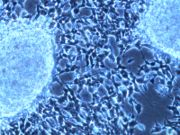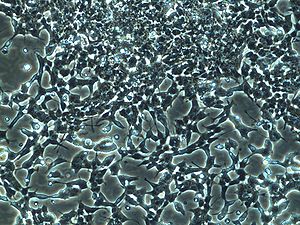
SH-SY5Y
Encyclopedia

History
The cell line SH-SY5Y is a human derived neuroblastomaNeuroblastoma
Neuroblastoma is the most common extracranial solid cancer in childhood and the most common cancer in infancy, with an annual incidence of about 650 cases per year in the US , and 100 cases per year in the UK . Close to 50 percent of neuroblastoma cases occur in children younger than two years old...
cell line, thrice-cloned originally from SK-N-SH and first reported in 1978. A neuroblast-like subclone of SK-N-SH, named SH-SY, was subcloned as SH-SY5, which was subcloned again as SH-SY5Y . The cloning process is essentially artificial selection, involving expansion of individual cells or a small group of cells that express a particular phenotype of interest. This cell line is genetically female (has two X chromosomes, but no Y), as the original line was established in 1970 from a bone marrow biopsy of a metastatic neuroblastoma site in a four year-old female .
Morphology
The cells possess an abnormal chromosome 1, where there is an additional copy of a 1q segment and is referred to trisomy 1q. SH-SY5Y cells are known to be dopamine beta hydroxylase active, acetylcholinergic, glutamatergic and adenosinergic. The cells have very different growth phases, outlined in the surrounding pictures. The cells both propagate via mitosisMitosis
Mitosis is the process by which a eukaryotic cell separates the chromosomes in its cell nucleus into two identical sets, in two separate nuclei. It is generally followed immediately by cytokinesis, which divides the nuclei, cytoplasm, organelles and cell membrane into two cells containing roughly...
and differentiate by extending neurites to the surrounding area. While dividing, the aggregated cell
Cell (biology)
The cell is the basic structural and functional unit of all known living organisms. It is the smallest unit of life that is classified as a living thing, and is often called the building block of life. The Alberts text discusses how the "cellular building blocks" move to shape developing embryos....
s can look so different from the differentiated cells, that new scientists often mistake one or the another for contamination. The dividing cells can form clusters of cells which are reminders of their cancerous nature, but certain treatments such as retinoic acid
Retinoic acid
Retinoic acid is a metabolite of vitamin A that mediates the functions of vitamin A required for growth and development. Retinoic acid is required in chordate animals which includes all higher animals from fishes to humans...
and BDNF can force the cells to dendrify and differentiate.

Media and Cultivation
The most common growing cocktail used is a 1:1 mixture of DMEM and Ham's F12 medium and 10% supplemental fetal bovine serumFetal bovine serum
Fetal bovine serum or FBS is the portion of plasma remaining after coagulation of blood, during which process the plasma protein fibrinogen is converted to fibrin and remains behind in the clot. Fetal bovine serum comes from the blood drawn from a bovine fetus via a closed system of collection at...
. The DMEM usually contains 1.5 g/L sodium bicarbonate
Sodium bicarbonate
Sodium bicarbonate or sodium hydrogen carbonate is the chemical compound with the formula Na HCO3. Sodium bicarbonate is a white solid that is crystalline but often appears as a fine powder. It has a slightly salty, alkaline taste resembling that of washing soda . The natural mineral form is...
, 2 mM L-Glutamine, 1 mM sodium pyruvate
Sodium pyruvate
Sodium pyruvate is commonly added to cell culture media as an additional source of energy, but may also have protective effects against hydrogen peroxide. This was reported by Giandomenico et al.. and has been confirmed by several independent groups....
and 0.1 mM nonessential amino acids. The cells are always grown at 37 degrees Celsius with 95% air and 5% carbon dioxide
Carbon dioxide
Carbon dioxide is a naturally occurring chemical compound composed of two oxygen atoms covalently bonded to a single carbon atom...
. It is advised to cultivate the cells in flasks which are coated for cell culture adhesion, this will aid in differention and dendrification of the hybridoma
Hybridoma
Hybridoma technology is a technology of forming hybrid cell lines by fusing a specific antibody-producing B cell with a myeloma cell that is selected for its ability to grow in tissue culture and for an absence of antibody chain synthesis...
.
SH-SY5Y has a dopamine-β-hydroxylase activity and can convert glutamate to GABA. Will form tumors in nude mice in approx. 3–4 weeks. The loss of neuronal characteristics has been described with increasing passage numbers. Therefore it is recommended not to be used after passage 20 or verify specific characteristics such as noradrenalin uptake or neuronal tumor markers.

